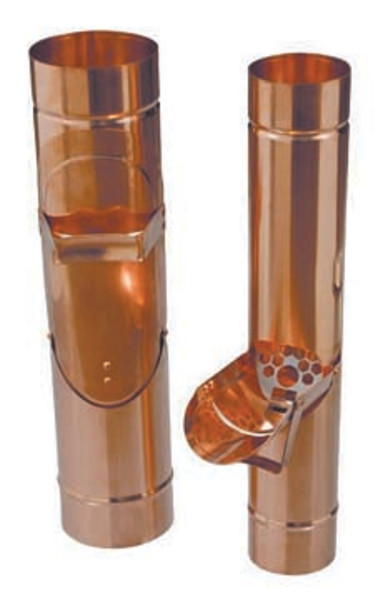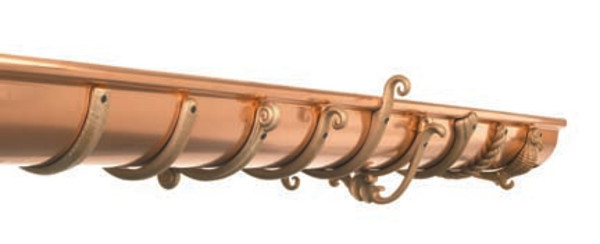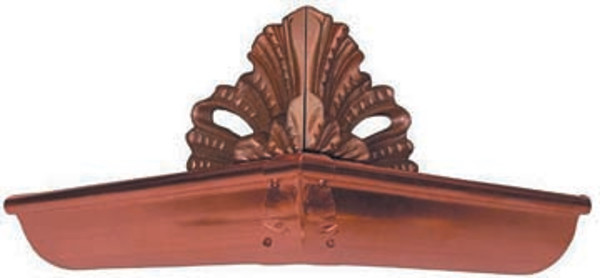The varied roofs on old houses require thoughtful gutter installations for best drainage, such as handling the large roof area of this double dormer. (All photos: Courtesy Classic Gutter Systems)
Every fall when it comes time to rake leaves and prepare a house for winter, a common question running through many minds is: What do I need gutters for anyway? Fortunately, old-house owners know better. Good gutters collect roof runoff and divert the water away from the building, keeping basements dry and exteriors free from destructive splashback. The bigger question is how to best help gutters do their job over the longest possible lifespan? That answer depends upon the gutter’s material and the installation.
Q: Do I have to climb up and clean every season, or just once a year?
A: It depends upon the gutter and the house. Annual inspections are a good practice, but buildings with a lot of overhanging trees, say, frequently need attention twice a year. Old gloves and a child’s rake are favorite tools for cleaning gutters. Some folks also gather up leaves and muck with a large, rubber pastry spatula. Wire strainers that fit in the trough drain have been used for years to keep sticks, baseballs, and other large objects away from the downspout.
Downspout cleanouts are clever maintenance accessories made by several manufacturers, and also act as diverters for watering plants.
Q: Should gutters be painted? On the inside or the outside?
A: You should paint the outside of wood gutters to protect the wood. Copper and galvanized gutters generally do not require an exterior coat, but you might want to paint them to match the exterior of your house. When it comes to painting the inside of the gutter, the answer depends primarily on the construction of the gutter. Wood gutters must breathe through the trough surface to dry out (when not conducting water). Since multiple layers of paint in a trough will resist water vapor migration, water vapor collects under the paint film and ultimately lifts it, or it migrates through the wood, causing the paint to blow off (peel away) from the exterior. Either way, the gutter becomes prone to rot.
What is recommended tends to fall into the category of a highly breathable coating or none at all. In the Northeast, Douglas fir gutters are usually maintained with a treatment that resists liquid water but is permeable to water vapor. This can be a commercial (toxic) wood preservative, or raw linseed oil thinned between 1:1 and 3:1 with mineral spirits or turpentine. Some people simply thin the linseed oil with preservative. Whatever the treatment, apply it annually when the wood is thoroughly dry, using multiple coats if necessary to sufficiently imbue the wood.
Existing galvanized steel gutters are another story, and benefit greatly from troughcoating with a good quality metal primer or metal roof paint. Be sure to touch up or renew these coatings every year. In contrast, new gutters should not be painted until after their first or second season. The galvanizing process leaves a new gutter with a smooth, oily surface that has no tooth, and paint will flake off shortly after it is applied. Once the gutter has been exposed to the elements, however, acid rain will slightly etch the surface, so that after a full cleaning with a mild acid such as vinegar the paint can grab the metal.
Solid gutter hangers add design flair under half-round gutters while providing maximum support against the weight of snow or ice.
While copper gutters take paint well (better than galvanized steel), painting is not required for longevity. In fact, one of the beauties of copper is that it self-diagnoses its flaws. On bare metal, small leaks leave watermarks or trails where they have originated; problems are not so apparent when the metal is painted. Repairs too are much simpler on an unpainted gutter. The natural verdigris oxidation that helps preserve the metal is easily removed with flux after light sandpapering. Most punctures or broken seams can then be soldered shut again by a competent craftsman.
Q: Can I treat my wood gutters with tar or motor oil to protect them?
A: Coating any gutter with roofing tar, asphalt products, or elastomeric products causes problems. These materials eventually break, trapping water between coating and gutter, and leading to deterioration of wood or metal. Painting wooden gutters with used engine oil or gear lubricant is a thrifty idea, but a poor one. Not only can these oils cause paint adhesion problems, they also carry acids and combustion waste products in suspension—no better for wood than for machinery.
Spillover guards may look only ornamental in good weather, but in heavy rain they keep water from washing over corners and down the walls.
Q: Though I clean my gutters every year, they always have water in them. Why?
A: Perhaps you should check their pitch. Ice, falling limbs, or settling of the house may have shifted the gutter so that it does not drain quickly or completely. Strictly speaking, ideal pitch is a function of gutter size, roof area, and average rainfall. However, many builders and gutter tradespeople use a rough rule-of-thumb for minimum pitch—for instance, 1” of drop for every 10′ of length. (This guideline may require adjustments if the gutter is very long or the eave is not level.) To check the operation of a gutter system, get up on a ladder and run a hose in the gutter to see how it flows.
In addition, check the location and number of drains and downspouts. Older houses—particularly those from the late 19th century with complex roofs—are often underspec’ed in terms of drainage and adding outlets may improve capacity and correct spillover problems. For example, a gutter 35′ or longer may be better served by downspouts at each end rather than a single outlet. In such a case, the gutter is rehung so that the high point is at the center and it drops in each direction toward the downspout—a scheme that also makes a steeper pitch more visually appealing on longer runs.







